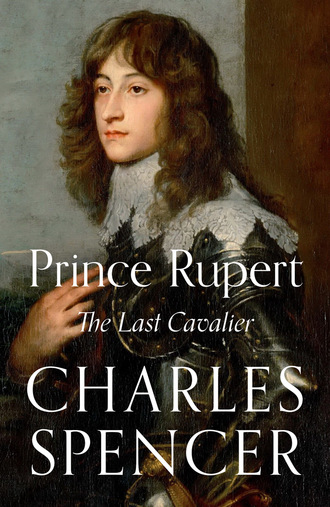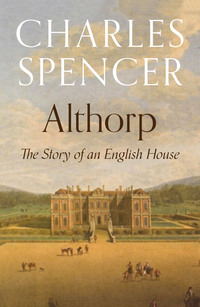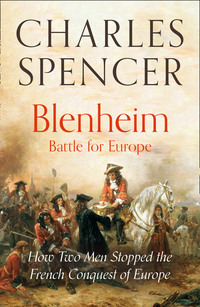
Полная версия
Prince Rupert

PRINCE RUPERT
THE LAST CAVALIER
Charles Spencer

Copyright
William Collins
An imprint of HarperCollinsPublishers
1 London Bridge Street
London SE1 9GF
WilliamCollinsBooks.com
This eBook first published in Great Britain by William Collins in 2020
This edition first published by Endeavour Press Ltd. in 2014
First published by Weidenfeld & Nicolson in 2007
Copyright © Charles Spencer, 2007
Cover image © Getty Images
Charles Spencer asserts the moral right to be identified as the author of this work
A catalogue record for this book is available from the British Library
All rights reserved under International and Pan-American Copyright Conventions. By payment of the required fees, you have been granted the non-exclusive, non-transferable right to access and read the text of this e-book on-screen. No part of this text may be reproduced, transmitted, down-loaded, decompiled, reverse engineered, or stored in or introduced into any information storage and retrieval system, in any form or by any means, whether electronic or mechanical, now known or hereinafter invented, without the express written permission of HarperCollins
Ebook Edition © September 2020 ISBN: 9780008373252
Version: 2020-07-28
Dedication
TO LARA
Contents
Cover
Title Page
Copyright
Dedication
Introduction
Chapter One: Baptism of Fire
Chapter Two: Childhood
Chapter Three: Boy Soldier
Chapter Four: Prisoner of War
Chapter Five: To His Uncle’s Aid
Chapter Six: Edgehill
Chapter Seven: The Curse of Parliament
Chapter Eight: Faction Fighting
Chapter Nine: Rushing to Defeat
Chapter Ten: Commander of the King’s Forces
Chapter Eleven: No Hope of Better Things
Chapter Twelve: A Matter of Honour
Chapter Thirteen: French General
Chapter Fourteen: General at Sea
Chapter Fifteen: Pirate Prince
Chapter Sixteen: Suffering for the Cause
Chapter Seventeen: Maurice
Chapter Eighteen: Wilderness Years
Chapter Nineteen: Restoration
Chapter Twenty: Man of War
Chapter Twenty-One: Joint Command
Chapter Twenty-Two: ‘Sadtroublesome Times’
Chapter Twenty-Three: The Happiest Old Cur in the Nation
Chapter Twenty-Four: Windsor Castle
Chapter Twenty-Five: Hudson’s Bay
Chapter Twenty-Six: The Wrong Enemy
Chapter Twenty-Seven: Death of a Cavalier
Footnotes
Bibliography
Author’s Note
Acknowledgements
About the Author
About the Publisher
Introduction
Prince Rupert of the Rhine — it’s a name touched in equal parts by glamour and glory, defeat and disappointment. The poster boy of the Royalist cause, Rupert attracted the unrestrained bile of Parliament’s busy propagandists. They poured out pamphlets besmirching the aims and intentions of the king’s talismanic nephew. His reputation has never fully recovered. However, he has never wanted for admirers: his many portraits show a good-looking and intelligent man, confident and focused. If opinions on the prince are divided, this has long been the case. He achieved his contentious status during some of the most divisive years in British history, which saw Charles I fighting Parliament in the English Civil War.
Those casually acquainted with the conflicts of the 1640s usually know something of the prince’s military reputation — most likely that he was the leader of thundering cavalry charges, which overwhelmed opponents with the shock of their initial impetus, before spinning off the battlefield in woeful indiscipline. There is certainly truth in this popular image: at the first and last of the great Civil War battles, Rupert’s troops sliced effortlessly through the enemy, then galloped after their foes instead of regrouping and re-engaging. At Edgehill, this unruliness robbed the king of victory. At Naseby, massively outnumbered, Royalist failure was probably inevitable, but the early absence of the prince and his squadrons made defeat certain and complete.
At 6 foot 4 inches tall, the sheer physical presence of Rupert was difficult to ignore. He attracted enormous attention from contemporaries. To his followers, he was a man ‘whose very name was half a conquest’. The Marquess of Newcastle, a key Royalist grandee in northern England, wrote to the prince on this theme: ‘Your name is grown so triumphant, and the world’s expectations to look for more from you than man can do; but that is their fault, Sir, and not yours. Long may you live … a terror to your uncle’s enemies, and a preserver of his servants.’
The enemy viewed him in a more apocalyptic light: a Scottish observer, writing in 1644, summoned an awful image of the prince’s approach of the city of York: ‘The manner briefly was thus, Rupert, or the second Nimrod, the mighty Plunderer, the beginning of whose kingdom is confusion, comes in his hunting carrier, with his fellow hunters, and near 20,000 bloodhounds attending them, all more ravenous than wolves, and fiercer than tigers, thirsting for blood.’ To Parliament, the prince was a figure of terror.
When examining Rupert’s life, it is important to do so against a time line: the headline events frequently occurred when he was still very young. Born the son of a newly crowned king and queen, he embarked on a life of exile while still an infant. He gained a reputation as a notable soldier in his teens, exhibiting examples of the courage that marked his life and which frequently verged on the insane. Eventually he was taken prisoner of war. He endured years of incarceration, with periods of genuine deprivation and hardship. However, he used this time to develop his interests in art and science (which would remain dear to him throughout his life), and also experienced his first love — with his gaoler’s daughter.
The prince was returned to freedom as the clouds of civil warfare settled over England. Aged 22, he arrived in time to take command of his uncle’s 800 horsemen, and set about reinforcing and transforming them. They quickly became an eye-catching strike force. Dismissed by Parliament as demonic ‘cavaliers’, loose-living rapists and pillagers, Rupert moulded them into the most feared and effective part of the Royalist army.
The myth of the prince and his cavaliers evolved early in the conflict. On a warm day in the autumn of 1642, Rupert, his brother Maurice, and several of their comrades took time off from convoy duty to lie on the grass near Powick Bridge. Their breastplates lay beside them, while their horses grazed nearby. Suddenly the princes spotted the Life Guard of the Earl of Essex, the enemy lord general, riding towards them at the head of a significant force.
Logic dictated a speedy retreat to the safety of nearby Worcester. Instead, Rupert shouted to his officers to follow him. He then sprung onto his horse and immediately galloped directly at the rebels. The rest of the Royalists went after their young general as quickly as they could: the first proper engagement of the Civil War was joined.
Perhaps only fifty rebels were slain at Powick Bridge, but the significance of the day lay beyond the body count. Parliament had anticipated a short campaign, with speedy victory over a king who was believed to be unpopular and poorly equipped for warfare, but this reverse caused a huge dent to morale at Westminster. Several prominent rebel officers were among the dead and Rupert had shown that his gallantry, and that of his devoted followers, stood between Parliament and victory.
The English Civil War was the backdrop to Rupert’s most famous exploits. His flair on the battlefield led to hopes of finishing off Parliament, in 1643. However, Rupert found he faced enemies who were harder to defeat than those arrayed against him on the battlefield: his colleagues in the king’s council of war were divided, several of them suspicious and resentful of the young, foreign princeling, who enjoyed Charles I’s full favour. The Royalist cause was hamstrung by these internal divisions, which reduced Rupert to smouldering resentment. Meanwhile, Parliament refined its resources, and trained an army of a calibre that the king never possessed.
The prince became increasingly senior, militarily. Victories in the north were nullified by his humiliating defeat at Marston Moor. Naseby followed. His nadir came with the surrender of Bristol, then England’s second city, which allowed Rupert’s enemies to portray him, completely unfairly, as treacherous to the king. As Charles I spiralled towards ultimate defeat, he was ready to believe anything — even that his nephew was responsible for his key reverses. The weak monarch suspected his sister’s son, who was one of his most loyal commanders, rather than question the conniving courtiers who hated the bloodied hero.
After the Civil War, Rupert found brief employment in Louis XIV’s armies. However, he always had one ear cocked, waiting for the summons to serve his uncle’s cause once more. When the call came, he ignored his lack of experience at sea to lead the Royalist navy. It was a difficult assignment, which nobody else wanted. Rupert’s most heroic years followed, as he kept the Stuart banner flying while Parliament triumphed everywhere else. However, the effort of survival was enormous and exacted a heavy cost. The remainder of the prince’s life betrayed the ravages to his health incurred on royal duty.
When tackling Rupert’s life story, I was determined that only a third of the text should cover the key Civil War years of 1642-5: for a man who lived into his sixties, it seemed ridiculous to allot any more space to the four years that established his reputation. Fortunately, the rest of Prince Rupert’s days were filled with fascinating events, as his enquiring mind and his restless spirit took him in a variety of directions.
Every subject of a biography is, of course, to some extent, a product of his or her age. Of Rupert this is particularly so: his experiences, tastes, and interests were reflective of those preoccupying many European aristocrats and princes in the middle decades of the seventeenth century. He was enmeshed in one war after the other, hoping that battlefield success would lead to riches and glory. While he was a brilliant and charismatic cavalry general, he never progressed to successful overall command. However, soldiery — on land and sea — remained his vocation into late middle age.
His wider pursuits were typical of an active patrician with a good brain — many of his hobbies coincided with those of his first cousin, Charles II. Both men, predictably, enjoyed hunting and shooting, pursued actresses (although Rupert’s conquests were paltry in comparison to the king’s plenty), and played energetic tennis: Rupert was reputedly the finest player in England.
However, not all energies were expended in the bedroom and on the sports’ field. Rupert, like Charles II, had a burning interest in science. The Restoration coincided with an expansion of knowledge in chemistry, 1661 seeing the appearance of Robert Boyle’s The Sceptical Chymist, as well as the foundation of the Royal Society. Rupert was one of its first members. He was never afraid to dirty his own hands, spending happy, sweat-drenched, hours labouring in his laboratory and at his foundry. The Prince’s inventions mainly had a military theme, but he also brought mezzotint engraving to Britain. Some believe that he devised the process.
Financial insecurity was Rupert’s constant spur. It explains his never-ending pursuit of business schemes: he was determined to slough off the poverty bequeathed him as a younger son of a dispossessed royal family. The most enduring legacy of this search for wealth is the Hudson’s Bay Company, which the prince established and championed. It opened up vast areas of what is now Canada. The town of Prince Rupert, just south of the Alaskan/Canadian border, is a reminder of Rupert’s interest in North American trade and exploration.
Why write a biography of Prince Rupert now? There have been times when Rupert was better known than is currently the case. Eliot Warburton’s three volumes in the 1840s brought to light much of the correspondence and commentary attached to the glory days of this fascinating man. Subsequent biographies have also tended to concentrate on the Civil War years: there were three such works in 1976 alone. More recently, Frank Kitson has divided Rupert’s military career into two distinct phases — his years as a young general, and those as a middle-aged admiral — and analysed both.
My book looks at the whole man, as well as the context of his life. It does not claim to contain a definitive study of the Civil War, nor of the later Anglo-Dutch Wars. I have instead endeavoured to tell the tale of an intriguing individual, who frightened and inspired his contemporaries, and who was at the centre of a succession of fierce, personal quarrels. His particular foes were George Digby, a foppish courtier, and Samuel Pepys, the inspired naval bureaucrat most often remembered for his diaries.
Rupert was not an easy man. He was a cavalier, but certainly not of the laughing variety. At his best, he was serious, loyal, inspirational, and incisive. At his worst, he was arrogant, inflexible, and irascible. However, he lived life with passion and energy. He regarded himself as a man who would always do the right thing, whatever the cost. His lack of compromise was at once his greatest gift and his most significant impediment.
Prince Rupert of the Rhine hails from a different era, but his conflicting complexities are recognisable to all today that have a broad and compassionate view of the human condition. Writing his latest biography has left me an admirer of this fascinating man, accepting of his shortcomings, and in awe of his extraordinary physical courage. Above all, it is the range of his experiences that is most startling. It is hard to believe that one man packed so much into a single lifetime.
Chapter One
Baptism of Fire
‘Swaddled in Armour, Drums appeasd thy Cries, And the Shrill Trumpet sang thy Lullabies.’
Thomas Flatman, On the Death of the Illustrious Prince Rupert, a Pindarique Ode
Rupert was born in Prague on 17 December 1619, at half past ten at night. He was the third son, and fourth child, of a union that exuded glamour and promised glory. His mother Elizabeth was a British princess famed as a romantic icon throughout the Continent. His father Frederick V was Count Palatine, one of the foremost Protestant princes of Europe. ‘From thy noble Pedigree,’ Rupert’s eulogist would conclude, ‘The Royal Blood … sparked in thy veins.’[fn1] The princeling’s royal heritage was of a north and middle European stamp: his grandmothers were princesses, one Danish, the other Dutch; his maternal grandfather was James I of England. When James heard that his only surviving daughter had produced a new grandson, he pressed a purse of gold coins into the messenger’s hands, before ordering the drinking of toasts.
Frederick and Elizabeth invited their subjects to file past their baby. Rupert lay in an ebony cradle — a symbol of the rich luxury that they assumed would be his lifelong companion. Another of his gifts was a silver ship, a prophetic offering, for some of Rupert’s most fascinating and challenging years would be at sea. Since he was native-born, unlike his two older brothers, there were calls for Rupert to be declared heir to his parents’ new kingdom — a proposal that failed in the Bohemian parliament by one vote. However, the neighbouring territory of Lusatia proclaimed Rupert as its prince.
Rupert’s christening took place on 31 March 1620, a contemporary recording: ‘The solemnity of his baptism was very extraordinary, there being present the King himself, his brother, two princes of the House of Saxony, the Duke of Anhalt, Elector of Hohenloe, with many other persons of eminent condition …’[fn2] He was named after an ancestor who had been Emperor between 1400 and 1410, Rupert the Clement. The young prince inherited his forebear’s Christian name, not his disposition.
Bethlem Gabor was chosen as godfather: he was a formidable, Transylvanian, nobleman who claimed the throne of Hungary. Unable to attend the christening in person, he sent Count Thurtzo to represent him. The count, in body armour, received the infant from the priest and held him: a gesture that signalled his absent master’s duty of guardianship. Thurtzo then passed Rupert to the deputies of the Bohemian dependencies, who were also encased in armour. The sight of breastplates and swords in a cathedral was indicative of the close intertwining of the religious and the military in early seventeenth-century Europe. This was a time when senior ecclesiastical figures were at the centre of politics and lay princes were entrusted with spiritual duties.
Rupert’s father had recently, by request, become King of Bohemia, with Elizabeth his queen. The Bohemian nobility needed a Protestant champion to replace, and then stand up to, the Catholic Habsburgs, whom they had recently overthrown. Frederick, after much agonising, had agreed to take on the role. Rarely can the acceptance of an invitation have sparked such colossal devastation. Rupert’s birth took place after the fuse had been lit and just before the powder keg went up. Even as the boy’s arrival was celebrated, plans were forming in Catholic Europe that would impact fatally on his parents’ rule and set the newborn’s life on its helter-skelter course.
*
When Rupert’s parents married, in 1613, it was the conclusion of his mother’s exhaustive search for a suitable husband. By the standards of the age, Elizabeth’s clean features and height marked her out as handsome. Her lineage and charm persuaded people, somewhat against the evidence of her portraits, to declare her a great beauty. There was, however, no doubting her personality. Elizabeth had a confidence and sparkle inherited from her charismatic grandmother, Mary Queen of Scots. Unfortunately, Elizabeth would also match her tragic ancestress for heartbreak.
The princess was seven when her father left Scotland to assume the English throne. It had been left vacant by the death of the girl’s godmother, Elizabeth I. From the start young ‘Lady Elizabeth’ was hugely popular, provoking delighted admiration and praise from all who met her. James believed that royal children prospered better if kept away from the distractions of court life, so Elizabeth was handed over to an aristocratic couple, Lord and Lady Harington — ‘persons eminent for prudence and piety’[fn3] — for a strict education. The reports from their residence at Combe Abbey, near Coventry, were consistently enthusiastic: ‘With God’s assistance’, Lord Harington wrote, ‘we hope to do our Lady Elizabeth such service as is due to her princely endowments and natural abilities; both which appear the sweet dawning of future comfort to her royal father.’[fn4]
This princess of rare qualities was celebrated throughout the kingdom. If the Gunpowder Plot of 1605 had been successful in blowing up James and his sons, the conspirators had intended to kidnap Elizabeth, have her crowned, and bring her up a Catholic. ‘What a queen should I have been by this means!’ she said when told of the plan, ‘I had rather have been with my Royal Father in the Parliament House, than wear his Crown on such condition.’[fn5]
As womanhood approached Elizabeth’s hand became much sought after overseas. The French ambassador met the princess when she was 11 and was captivated by her poise. ‘I assure you’, he reported to Paris, ‘that it will not be her fault if she is not dauphiness — and she might have worse fancies — for she is not at all vexed when it is mentioned to her.’[fn6] Sir Walter Raleigh thought Elizabeth ‘by nature and education endowed with such princely perfections, both of body and mind, as may well deserve to be reputed a worthy spouse for the greatest monarch in Christendom’.[fn7] Her lengthy list of failed suitors included the kings of Sweden and Spain, the Dauphin of France, and Maurice of Nassau, the Dutch leader.
The collapse of the Spanish suit helps to explain Elizabeth’s eventual choice of husband. James I had hoped that such a union would underline the end of hostilities between England and Spain, and advertise his wise and peace-loving kingship. However, his heir, Prince Henry, spoke for the majority of Englishmen when loudly rejecting his sister’s sacrifice to Popery. ‘The prince hath publicly said’, the Spanish ambassador was shocked to note, ‘that whosoever should counsel his father to marry his sister to a Catholic prince, were a traitor, and that it cannot be but to kill him and his brother, and make the succession theirs; he is a great heretic!’[fn8]
The most obvious Protestant match was the gifted Swedish prince, Gustavus Adolphus. However, Sweden was at war with Denmark, and the Danish king was Elizabeth’s maternal uncle, so this option fell away. Of the other choices, Frederick V, Count Palatine, was the candidate who stood out. He was the Palsgrave, or ‘Palace Count’, a role his family had filled since the tenth century. As such, he was the senior Protestant prince of the Holy Roman Empire — that hotchpotch of 300 Germanic, Bohemian, Lowland, and Italian lands, which was among the largest realms in Europe. The Count Palatine was one of the seven electors (the other six electors were the Archbishops of Cologne, Mainz, and Trier, and the King of Bohemia, the Duke of Saxony, and the Margrave of Brandenburg) charged by a fourteenth-century Papal Bull with the appointment of the Emperor. However, since the late Middle Ages, the throne — along with those of Hungary and Bohemia — had effectively become the possession of the Habsburg dynasty.
Frederick’s upbringing had more breadth to it than Elizabeth’s cloistered childhood. He had completed his education in Sedan, at the house of his uncle, the Duke of Bouillon. French was the main language spoken at Heidelberg, so this was an opportunity to progress to faultless fluency. His tutor was Tilenus, a Calvinist who stressed the need to guard against the evils of Catholicism. He planted in his pupil the lifelong conviction that the Pope, his Jesuit foot soldiers, and his Spanish Habsburg allies, were conspiring to undermine the rest of Europe for their own gain.
Religion was the cornerstone of a varied education. Frederick became a fine dancer, an adept swordsman, and an accomplished rider. By the time that he inherited the electorate, on his father’s death in 1610, Frederick had the makings of the perfect prince: he was devout, polished, and manly. The following year, when James I took discreet soundings about Frederick’s character and prospects from Bouillon, he received an enthusiastic critique: a perfect physique, a dark complexion and handsome face; a natural athleticism, particularly on horseback; a serious faith and pure morals; a wonderful portfolio of houses, including exquisite hunting lodges; and, when he came of age, arguably the most important electorate of the Holy Roman Empire. Eligibility was not a problem.
However, many in England had expected Elizabeth to marry a king. A prince, albeit one of Frederick’s fine pedigree, was considered too humble a match for the ‘Pearl of Britain’. Protestant supporters of the marriage felt it necessary to stress the importance of the Palatinate to the disappointed: ‘Now for his Highness’s Country’, wrote one of James I’s chaplains, ‘it is neither so small, unfruitful, or mean, as is by some supposed. It is in length about 200 English miles, the lower and the upper country. In the lower the Prince hath 26 walled towns, besides an infinite number of good and fair villages, 22 houses; and the land is very fruitful of wine, corn, and other comfortable fruits for man’s use, having the Rhine and the Neckar running through it. The upper Country hath not so many walled towns and princely houses, but those that are, be generally fairer than in the lower, especially Amberg and Newmarket [sic].’[fn9]





